Pansies are popular garden plants with colorful flowers. They are known for their distinct five-petaled flowers that bloom in the cooler months of spring, fall, and winter.
They are grown as annuals or biennials, ideal for both indoor and outdoor plantations. Pansies grow well in containers and pots. Potted pansies require more intensive care in pots as the pots hold substantially less growing medium.
To keep your potted pansies growing, water the plant regularly so that the soil is moist but not soggy. Good sunlight with temperatures 40-60°F is best for potted pansies. Add dilute fertilizers and bone meal to these plants every few weeks, and cut off damaged growth to keep the pansies thriving.
Potted pansies can experience many problems such as inappropriate watering, high temperatures, or poor fertilization that can cause issues like fungal diseases, pest infestation, and droopy leaves.
This guide will provide the basic care routine for pansies. It will also discuss possible reasons for suffering from pansies and will help in treating and solving them.
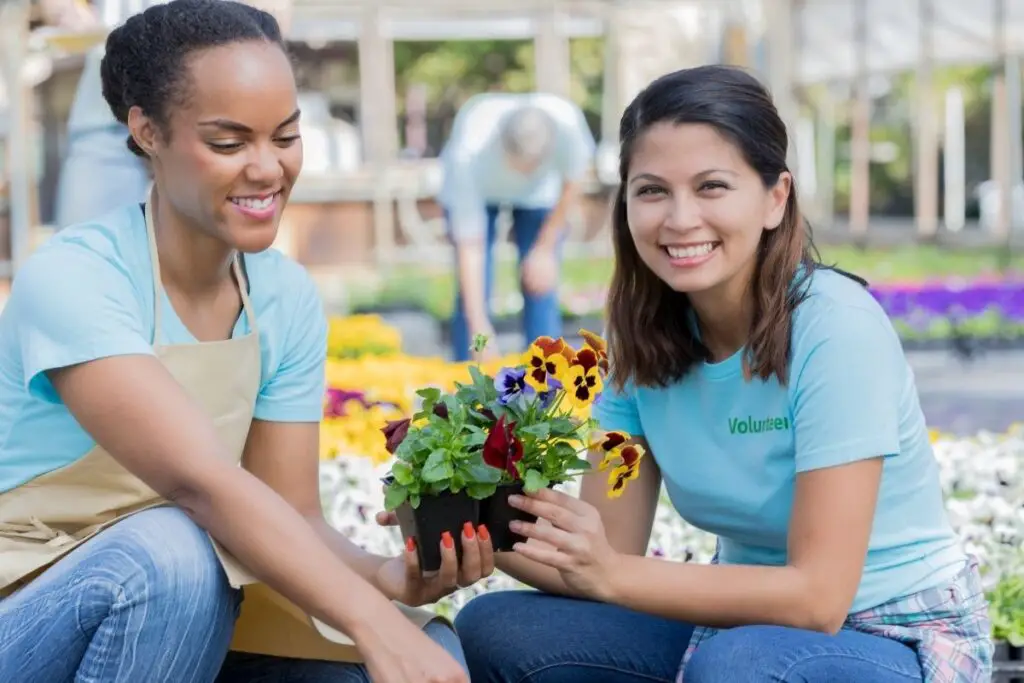
Pansies Overview
Pansies (viola × wittrockiana) are cultivated, hybridized violets are recognized for their multi-colored flat flowers and their fondness to cool temperatures.
The origin of these plants began in Buckinghamshire, England. The plant’s velvety flowers, which usually occur in blue, yellow, and white combinations, are about 2.5 to 5 cm in size and have five petals.
They are annual or short-lived perennial plants that grow about 15 to 30cm (6 to 12 inches) in height.
They are hardy plants and grow best in rich soil in a damp, cool climate.
Are pansies indoor or outdoor plants?
Pansies are ideally outdoor garden plants since they are hardy and easy to care for plants. They are also good indoor plants.
Pansies size, compact habit, and long flowering period make it a perfect plant for indoor plantation.
They are such plants that thrive in cool temperatures and become sensitive to excessive heat and humidity. Heat can cause pansies to be leggy and stop blooming.
So at such times, care for potted pansies is easy as you can easily bring these plants indoors to protect them from such harsh temperatures.
Also read: Are Pansy Indoor Or Outdoor Plants? (+When To Move Them Outside)
Do pansies grow well in pots?
Pansies are great for containers or pots. They are mainly grown as annuals or biennials in pots. They grow well in portable pots and can be moved to a cooler place when the sun starts to get stronger.
Growing pansies in a container or pot is an easy way to control moisture and soil type, and they will flourish beautifully if cared for properly.
Growing pansies in a pot depend on several factors such as the pot, soil type, water consistency, nutrition, and sunlight requirements. Pansies are colorful addition to your home when grown as a house plant.
When to plant potted pansies?
You can plant potted pansies from late summer to mid-autumn so that they can bloom through the winter and the following spring.
Pansies can be grown from seed, and it will take around 14 to 16 weeks before planting, usually in late January, and they will bloom from late spring to autumn.
But if you want to grow pansies for winter flowering, then sow seeds between May to June.
What is the correct way of growing pansies in pots?
There are two processes for growing pansies, i.e., seedlings and the transplanting process.
Seedling is the process of planting seeds in the soil, whereas transplanting is transferring the seedlings from the nursery to the pot.
Let’s discuss the steps involved in both processes.
Seeding process
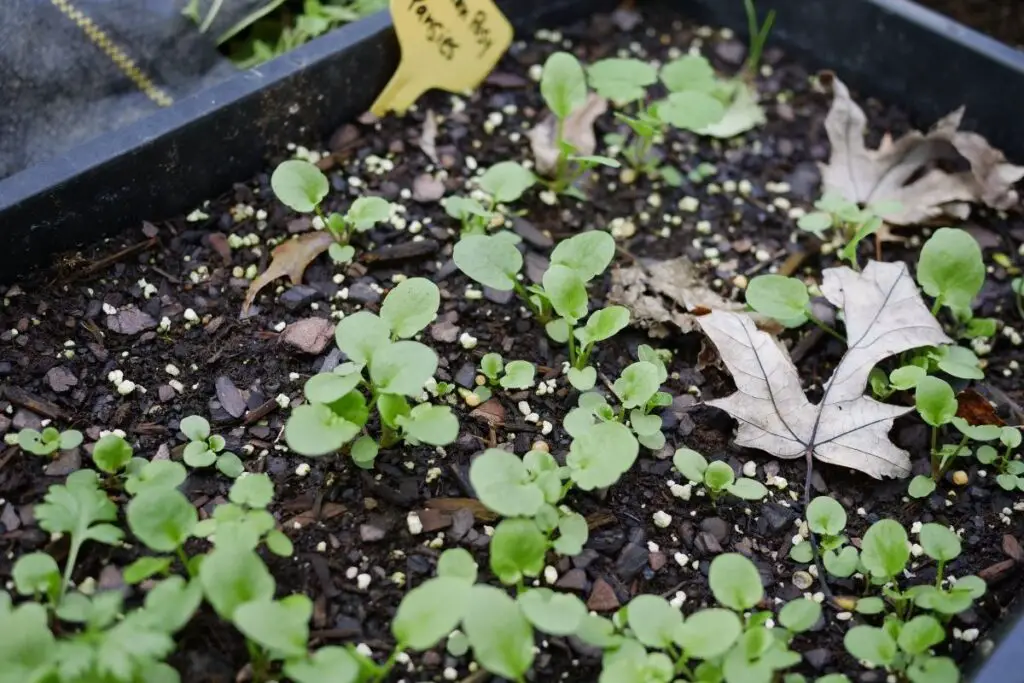
- First, place the pansies seeds over a soil-less seed–starting mix. It is usually a mixture of vermiculite and peat.
- Once the pot is filled, water them thoroughly, moisten the seed starting mix, and cover it with plastic or damp burlap until the seeds germinate, which will take around two weeks.
- Then remove the plastic and keep them in the shade until the seedlings develop their first set of leaves. Then they can stand direct sunlight as long as the soil is moist.
- Spray the soil gently while seeds germinate and for the first few weeks of growth.
- When seedlings have a proper set of leaves, begin fertilizing with a water-soluble fertilizer once a week.
- Water your pansies seeds regularly to keep the soil moist but not waterlogged.
Also read: Why Are My Pansy Seeds Not Germinating? (Possible Problems+Solution)
Transplanting process
- For transplanting, Select a large pot that supports proper drainage. Cover the bottom of that pot with a shade cloth.
- Fill the pot with soil mix. Add soil to the top of the container and then press it firmly. Create a hole in the soil for future transplants.
- Remove the seedlings from the seed tray. Use one hand to pull some soil and the other to set the plant in the hole so that the root ball is about 1 inch below the pot’s rim.
- Add fertilizer to the soil mix, fertilize the soil with a water-soluble fertilizer that contains nitrogen.
- Water the plant thoroughly. Add more potting mix if your pansies settle during watering.
Potted Pansy Care
Potted pansies need some care and attention for their proper growth.
These plants need a favorable growing environment with proper ideal temperature and humidity, direct sunlight, adequate water, good nutrition, and well-draining soil.
Since pansies growth depends on these factors, you always have to take off the proper fulfillment of these factors.
Read on to find about the soil, water, light, and other requirements of pansies and the points you need to remember.
Light requirement
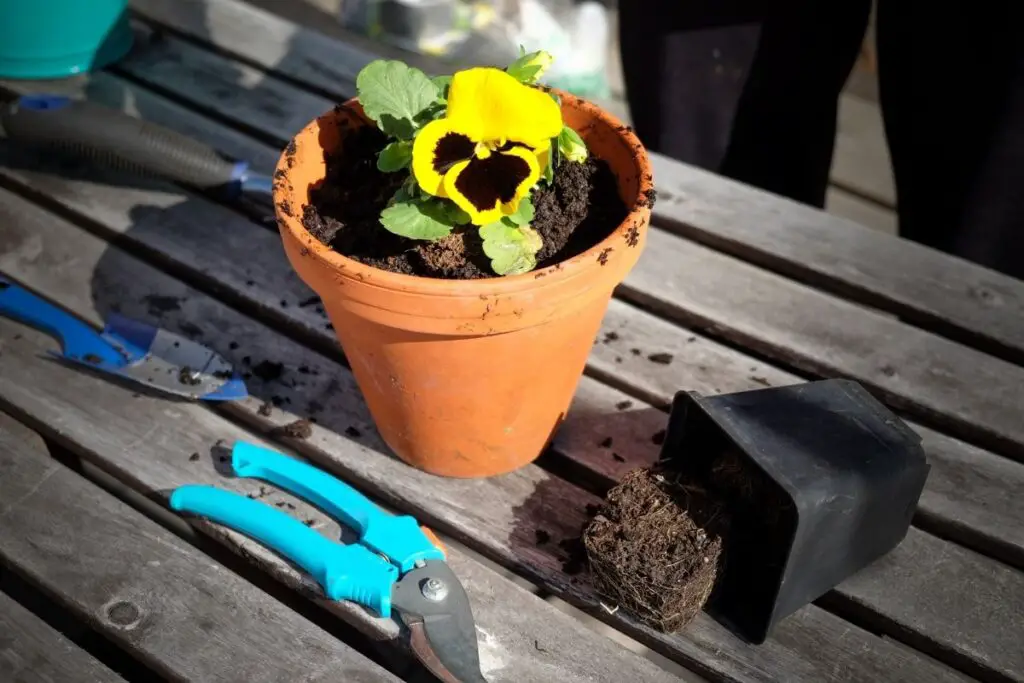
Potted pansies will need six hours of sun daily. So place your potted pansies in an area with full sun or partial sun. Never provide them with too much shade, as this will lower their blooming rate.
Ideally, pansies prefer a lot of sunlight in the spring and early summer, but they tend to struggle with too much heat. They will experience heat stress when the temperature goes above 90°F.
So keep your plant under shade by bringing them indoors. Also, never place pansies in the exact location for continuously three years as this will build fungal diseases that can feed your plant.
Also read: How Much Sun Do Pansies Need? (Pansies Light Requirements)
Looking for gardening supplies? We have tested 100's of products before recommending them to you guys. Check out our best pick below:
| Image | Gardening Supplies | Best Price? |
|---|---|---|
 Top
Top Top
Top | Raised Garden Bed Kit | Check On Amazon |
 | XLUX Soil Moisture Meter, Plant Water Monitor, Soil Hygrometer Sensor for Gardening, Farming, Indoor and Outdoor Plants, No Batteries Required | No Results |
 Top
Top Top
Top | 82 Pcs Garden Tools Set and Extra Succulent Tools Set | Check On Amazon |
 | Joeys Garden Expandable Garden Hose with 8 Function Hose Nozzle, Lightweight Anti-Kink Flexible Garden Hoses, Extra Strength Fabric with Double Latex Core, (50 FT, Black) | No Results |
 Top
Top Top
Top | Dual Chamber Compost Tumbler | Check On Amazon |
 Top
Top Top
Top | Sunnyglade Plant Stakes | Check On Amazon |
 Top
Top Top
Top | Organic Cold Pressed Neem Seed Oil | Check On Amazon |
 Top
Top Top
Top | Mighty Mint Gallon :-Insect and Pest Control Peppermint Oil | Check On Amazon |
 Top
Top Top
Top | Scotts DiseaseEx Lawn Fungicide | Check On Amazon |
 Top
Top Top
Top | Jacks Classic 20-20-20 All Purpose Fertilizer | Check On Amazon |
 Top
Top Top
Top | 30,000 Seeds Pollinator Attracting Wildflower Mixture | Check On Amazon |
 Top
Top Top
Top | Survival Vegetable Seeds Garden Kit-Over 16,000 Seeds | Check On Amazon |
Water requirements
Consistent moisture keeps your potted pansies soft and supple, but the root won’t tolerate soggy soil.
You should use a well-draining container for your plant. You should water your potted pansies regularly throughout the growing season, but allow the soil to dry between the waterings slightly.
The drier soil conditions also help your pansies to harden off and tolerate cold.
Give 1 inch of water per week when the pansies are actively growing. Do not overwater or let the water sit in the containers.
Always check the soil before watering. Overwatering will cause edema ( abnormal water retention in plants) to your pansies.
Water your potted pansies as often as possible, ensure the soil is moist but not soggy.
In winters, water your plant during the warmer daytime instead of the night to discourage freezing in soil.
Also read: How Much Water Does A Pansy Need? (Pansy Water Requirements)
Soil mix
Potted pansies do best in rich, organic, and well-drained soil. They like soil that drains out quickly and can hold sufficient moisture to dry out completely.
They prefer loose, rich soil with a slightly acidic pH level between 6.0 to 6.2. The soil temperature can be between 45 and 65°F.
You should use premium potting soil, a mix of peat, compost, moss, and vermiculite. This soil mix will add all the nutrition along with drainage and aeration.
Pansies thrive in moist soil, but they never like soggy soil. Soggy soil can cause root rot in pansies. Always avoid overwatering your plants by checking the moisture of the soil before watering.
Also read: What Type Of Soil Is Best For Growing Pansies? (+Best Soil Mix)
Fertilizer requirement
Pansies appreciate fertilizers, but too much food will make them leggy and will cause root damage.
For pansies in pots, apply liquid plant food roughly four weeks after planting and then feed your plants every two weeks with water-soluble fertilizers.
Mix liquid fertilizer with water in a watering can. Follow the instructions on the bottle.
Consider using plant food 15-10-5, which offers complete, balanced nutrition plus added iron that pansies need.
Add a little bone meal to your potted pansies every few weeks. Avoid adding heavy nitrogen fertilizers to your plants.
Pansies need fertilization in winters too, and you can use a formula-specific fertilizer and apply it every few weeks throughout the season.
Temperatures tolerance of pansies
Pansies will grow best when the night temperature is in the 40°F and the day temperature is 60°F range 16-25°C.
Warmer temperatures lead to leggy, floppy stem growth and fewer blooms. Pansies can tolerate cold, but they struggle with excessive heat and humidity.
Provide your potted plant with some shade, and do not keep them in direct sunlight. Also, you can mulch their soil surface for retaining moisture in hot weather.
Temperatures that drop below 25°C are likely to damage the flowers of pansies. At that time, the foliage will wilt and turn gray-green.
Also read: How Much Cold Can Pansies Tolerate? (+Winter Care)
Humidity for pansies
Potted pansies need 40-50% relative humidity around them. Excessive heat and humidity will create stress in plants.
When humidity drops, you can place your potted pansies on a tray of wet pebbles to increase the humidity level.
You can acidify mist water and apply enough mist to moisten the plants’ leaves but not wet the potting media. This avoids raising the pH in the pot while the plant is still cool.
Air circulation for potted pansies
You should place your potted pansies in such a manner that all the plants get the maximum space to reach their full potential.
If you crowd them, then they will compete for nutrients and space to spread their roots. A 10 to 12-inch container should not have more than three pansy plants.
Container or pot
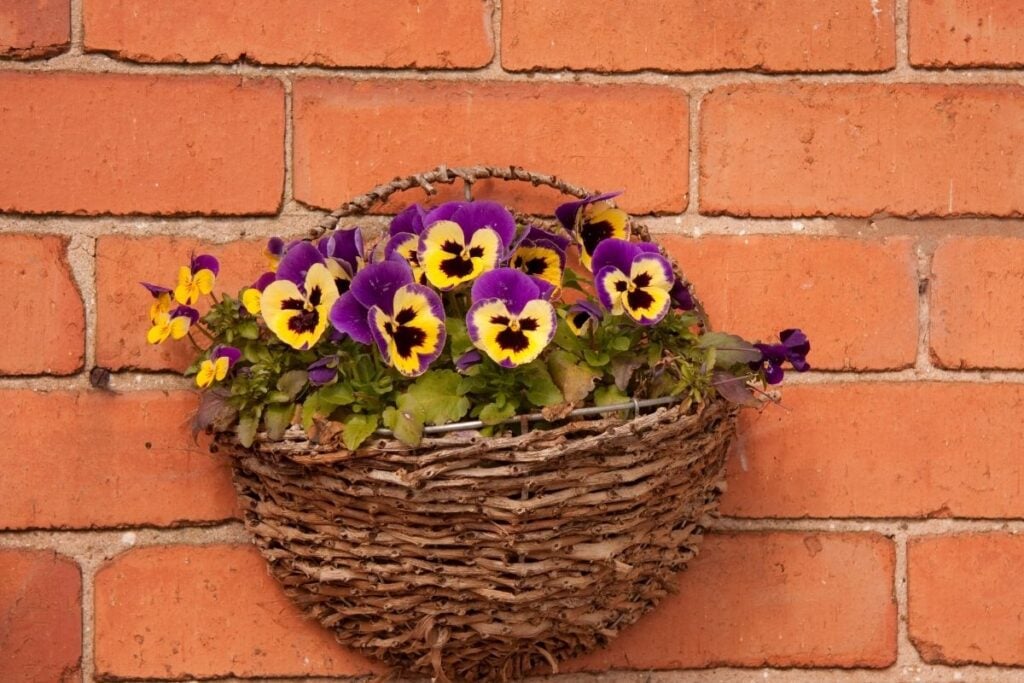
Pansies will grow in any pot that holds soil and supports drainage.
Plant your pansies in a pot that has lots of drainage holes. This will prevent overly wet soil in the pot.
You can grow pansies in small terracotta or concrete pots as these are the most suitable pots during summers. These pots will ensure proper air movement and drainage.
These pots are not suitable for winters as the water can soak into the wall of the pot, and it will make the walls freeze and expand that may cause the pot to crack.
You can use synthetic and glazed ceramic containers during winters. Ceramic containers will not get damaged by the winter freeze and ensure proper airflow and drainage.
The pot should not be less than 200 mm wide and deep in size.
Repotting
Repotting is the process of transferring the potted plants into another pot. Repotting is done when pansies have root rot or have become root-bound.
Root rot can happen due to overwatering or lack of light. This may cause your plant to die.
Rootbound happens when the plant has outgrown the pot, and the root starts to come out of the drainage holes.
In that case, you have to shift your pansies to a correct-sized pot and new potting mix.
Remove the damaged parts of the plants, place pansies in the new pot, add more soil, and adjust the plant in the soil.
Add enough water so that the plant doesn’t become stressed. The pot should have proper drainage holes that allow excess water to drain out easily and ensure proper airflow in the soil.
Repotting will give the pansies additional room to grow and help the plant recover all the lost nutrients from the old potting soil.
Also read: Can You Plant Pansies In Hanging Baskets? (+Choosing Basket+Care)
Pruning
Pruning of potted pansies is necessary. Potted pansies require timely pruning to maintain their beautiful appearance.
Pruning terminates the leggy growth and damaged parts of the plant and encourages new plant growth.
You should prune your potted pansies by removing dead flowers, injured leaves, and seeds pots to ensure repeat flowering.
If your potted pansies become leggy, you can cut them and let them grow to a more compact shape. Clip back dying pansy blooms where the stems meet the denser clump of foliage.
In case of pest attack or browning of leaves, you must remove the damaged leaves by pruning. Always use sharp scissors or pruners for pruning.
Potted pansies problems
Potted pansies can experience different problems. This doesn’t indicate that your pansy is dying. If you are aware, you can fix these problems with ease.
Keeping a check on pansies from time to time will help you detect the problems on time. Following is a list of these problems.
Problems caused by diseases:
- Root rot and crown rot
- Leaf spots
- Yellowing of leaves
- Gray Mold ( Botrytis Blight)
Problems cause by pests.
Other problems of potted pansies:
- Mottle pansies syndrome
- Short blooming period
- Nutrient deficiencies
- Drooping of leaves
- Warty growth on the stem
- Spindly and leggy growth
We will now discuss each point in detail.
Root rot and crown rot in pansies
Many fungi such as Phytophthora, Pythium, Rhizoctonia, and Fusarium live in the soil. They infect the roots or the base of the plant (crown) at the soil line. Potted pansies may wilt and die, and the leaves may turn yellow.
A dark sunken area may appear on the stem at or near the soil line. The root rot, and this makes the plant weak and stunted.
Solution :
- Choose pots that have a sound drainage system.
- Avoid giving too much water since many of the fungi thrive in moist soil.
- Allow the soil to dry out.
- Remove and destroy diseased parts to prevent future infections.
- Use fungicides that have potassium salts of phosphorus acid, which is an effective solution for fungus. Apply a chemical fungicide according to the directions on the label.
Leaf spots in potted pansies
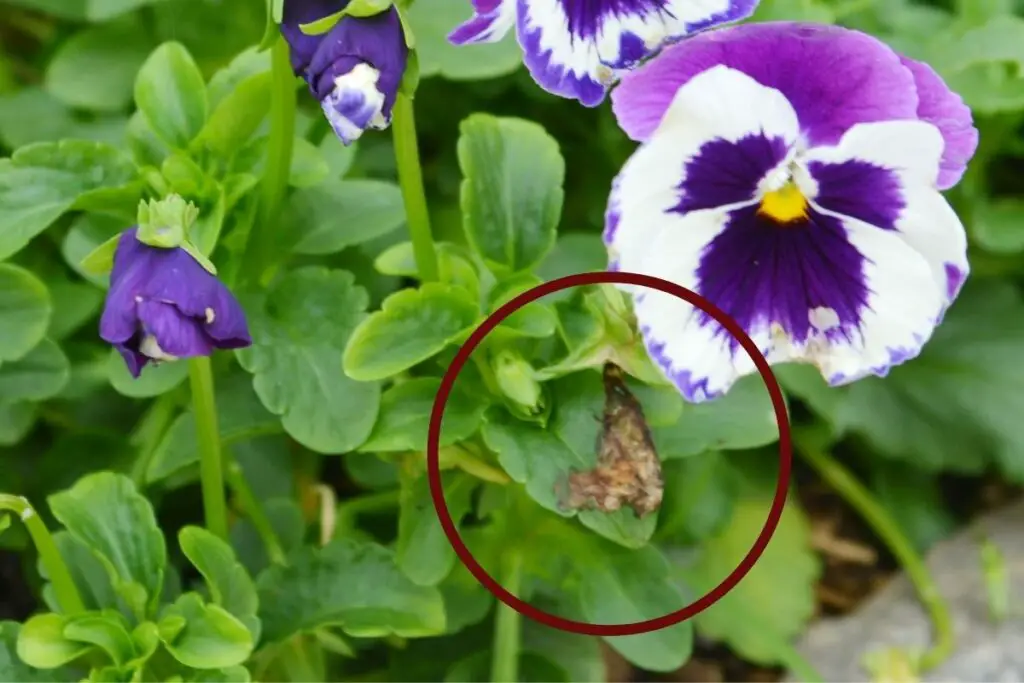
Leaf spot diseases might be caused by many fungi like Alternaria, Myrothecium, etc. If this occurs, you will notice spots on the leaves of your pansies.
Diseases like Anthracnose cause blotching, yellow spots, and black margins on leaves.
If you neglect these spots, they may grow more and join to form bigger spots on the leaves.
The disease makes the center of spots dry and tan and creates a concentric ring pattern. Severely infected plants may die.
Solution :
- Prune the infected leaves to stop the spread of this disease.
- Avoid overhead watering and mulch your pansies to prevent fungal spores from splashing.
- For severe infections of Anthracnose, use fungicide sprays that have chlorothalonil or mancozeb, which are suitable for treating this disease.
- To treat the Cercospora leaf spot disease, use thiophanate-methyl fungicide. Use this once in one or two weeks till you notice no signs of the disease. Read the instructions carefully.
Also read: Why Are My Pansy Leaves Turning Brown? (Causes+How To Fix)
Yellowing of leaves
Potted pansies can get affected by a fungal organism known as Thielaviopsis basicola that turns the plant leaves yellowish and produces crinkled leaves.
If you observe minutely, you might notice a discoloration starting the roots’ tips. This problem is also known as black root rot.
Solution :
- Discard and remove the infected plants.
- Endure proper drainage in soil and avoid overwatering.
- Use fungicides that have thiophanate methyl.
Also read: Why Are My Pansy Leaves Turning Yellow? (Causes+How To Fix)
Gray mold (Botrytis Blight)
Botrytis species causes this disease that creates a gray coating on your pansy plants.
If you take a look at the affected areas, you will notice decaying, fuzziness, and gray-colored spores.
Solution :
- Damp conditions help to worsen the condition or even cause it, so keep your pansies and its surroundings dry.
- Prune the blooms that have died and started decaying.
- Make sure your pansies receive good air circulation around them.
- Use fungicides that will help to save your pansies especially when the mold has caused a lot of damages.
Problems caused by pests
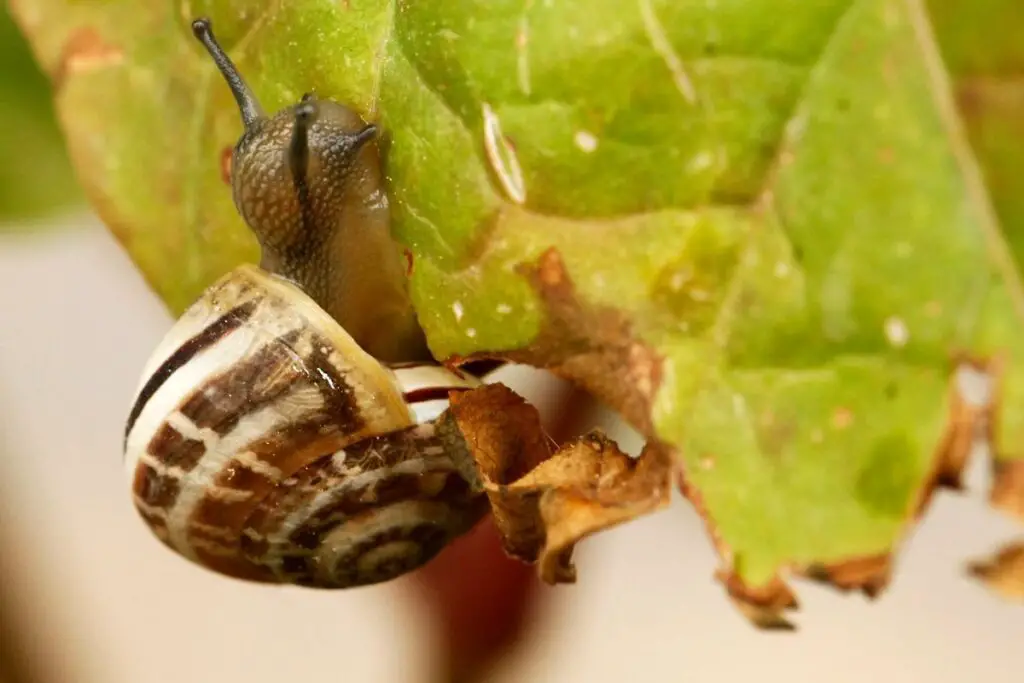
Pests are pathogens that interfere in the growth and cause damage to the plants. Pansies are generally affected by three types of pests. They are Aphids, spider mites, and snails or slugs.
Let’s discuss each pest in detail, along with prevention.
Aphids
Aphids are soft and tiny bugs that feed on the sap of your pansies.
Aphids mostly attack the latest leaves and stem coming out of your pansy plants. They also excrete honeydew and encourage fungal growth.
Solution:
- There are some insects like ladybirds that will eat the aphids. Ladybirds are attracted to the Queen Ann’s lace plant so growing these near your pansies will lead the ladybirds to the aphids.
- You can use insecticides and insecticidal soaps that remove the aphids. But use it carefully after reading the instructions.
Spider mites
Spider mites are closely related to spiders. Unlike most pests, spider mites don’t appear in moist environments as they prefer drier conditions.
They are too small to be noticed. They suck the sap of your pansies by piercing the tissues.
You will notice tiny holes in the pansies if they are infested by spider mites. You might also come across web-like structures under the leaves and flowers.
Solution:
- When infestations occur, spray potted pansies with insecticidal soap weekly as needed.
- You can use pesticides such as tau-fluvalinate or bifenthrin against spider mites.
Snails or slugs
Snail and slugs are common in gardens. These pests are hard to notice as they remain active and attack your pansies during the night.
So, you will notice holes in your pansies during the day but won’t find the pests as they hide under the leaves or pots.
Solution:
- Do not keep your pansies too moist as snails and slugs prefer moist conditions.
- You can remove snails and slugs by handpicking them. You can do this after the sun sets as this is when they start coming out.
- You can sprinkle sedimentary rock powder around the pansies to dehydrate and kill these pests.
- You can use sprays containing metaldehyde.
Also read: How To Get Rid Of Pests On Pansies? (Bugs Identification+Solution)
Short blooming period
Your pansies won’t bloom efficiently or for long if they experience extremely hot conditions and warm temperatures. If you expose them to temperatures above 75°F, you will notice shorter blooms.
Solution:
- For long blooming periods, you need to plant your pansies in low temperatures but not too low. The ideal months are fall and spring.
- Prune the plant and reduce the pressure. This will allow the pansies to concentrate on new growth and longer blooming conditions.
Also read: When Do Pansy Bloom? (+Help Pansy Bloom)
Leggy growth
You will notice leggy growth in your pansies if they are not getting enough light.
When the weather is cool and comfortable for your pansies, you need to provide them direct sunlight and when the temperatures rise, you must expose them to sufficient indirect light.
Solution:
Place your potted pansies in a location that provides an adequate amount of direct sunlight daily.
Also read: Why Are My Pansies Leggy? (+How To Fix A Leggy Plant)
Bumps on stems
If your pansies are overwatered, you might notice small bumps on the stems if you take a close look at these plants.
The excess water gets stored in the stems in the form of bumps. If you keep overwatering, these bumps burst due to the excess pressure from the water.
Solution:
- You must wait for the water to dry out before watering your pansies.
- Always use a well-draining soil and a pot with drainage holes for potted pansies.
- Do not apply too much mulch as that will retain a lot of water, causing overwatering.
Mottle pansy syndrome
Mottle pansy syndrome is a measurable or visible phenomenon in a plant’s growth and function.
Mottle pansy syndrome in pansies can be seen in warmer regions. Potted pansies that express this issue have multi-colored leaves.
If night temperature is cool and daytime high as near 80°F, the pansies lose the variegation and appear normal until heat stressed. However, under daytime heat and warm nights, the variegation continues on new growth.
With this syndrome, the leaves develop finger-like projections or become feathery. The growth will continue until temperatures are lowered, or fertility is increased.
Solution
Discard the plant.
Seeds express the variegated leaves almost immediately. Hold the seeds tray up into sunlight to remove the affected seedlings.
By scouting seed trays, you can eliminate these plants before they become a problem.
Nutrient deficiencies
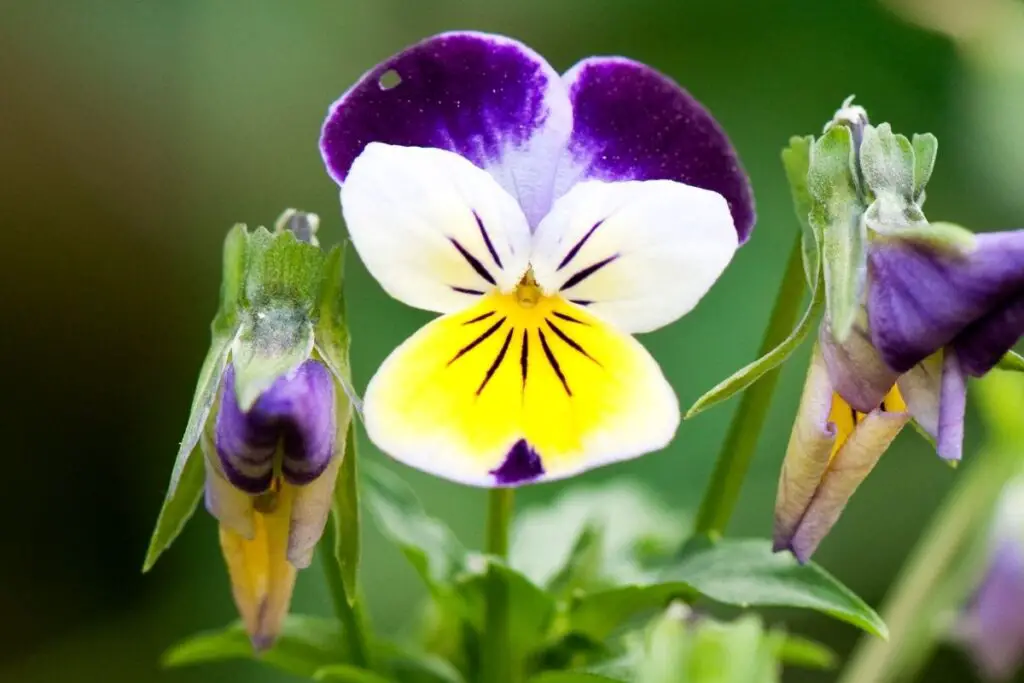
Nutrient deficiencies can cause different problems in your pansies. You might notice a change in the pH, chances are there that your pansies are experiencing nutrient deficiencies due to it.
The ideal pH level of pansies is between 5.4 and 5.8. So you must try to maintain it to avoid unnecessary problems.
Check the pH level of the soil in which the pansies grow. If the pH is above 5.8, your pansies can experience an iron or boron deficiency. This will affect their growth in the long run.
Your pansies will show different signs such as yellow leaves, chlorosis, etc.
Magnesium deficiency is another nutrient deficiency that will occur if the soil pH level drops below 5.4 or if there is a high calcium level in the soil.
The symptom of magnesium deficiency is interveinal chlorosis of the fully expanded younger leaves.
Solution:
Use a fertilizer that has micronutrients including iron and boron. It will help your pansies recover and balance out the pH of the soil.
Apply Epsom salt to your pansies if it lacks magnesium. You can add it to the water before watering your pansies or prepare a separate solution and give it to them.
Also read: Do Pansies Need Fertilizer? (What Type, How Much & More)
Pansies care tips
Potted pansies need little care and love to remain beautiful and healthy. If you keep a check on all these factors, your pansies will thank you with beautiful blooms.
Let’s look at an overview of the ideal conditions for growing pansies.
Light: Potted pansies need 6 to 7 hours of direct sunlight. You should place your potted pansies in a location where it gets enough sunlight throughout the day and partial shade in sweltering weather.
Water: Water your pansies daily during their growing season. Provide your mature pansies with 1 inch of water per week.
Soil: Potted pansies need well-draining and moist soil. Soil should provide enough breathing space and nutrition to plants.
Temperature: The ideal temperature for potted pansies is between 40 -60°F. A temperature change may stress your plants to a certain level.
Humidity: Maintain 40-50 % humidity around pansies. Use a tray of pebbles or apply mist to moisten plant leaves.
Air circulation: Provide space to your pansy plants. Don’t put so many pansies together in a pot.
Container or pot: Plant your pansy in a container with lots of drainage holes that ensure drainage and airflow. Use terracotta or concrete pot in summer and ceramic pots in winters.
Repotting: Sometimes, pansies can become root-bound. So you should transfer them to a new pot so that the roots can grow freely and remain healthy by absorbing nutrients from the soil.
Pruning: Remove the leggy growth and damaged parts of your potted pansies to encourage new blooms and growth. Pinch off dead flowers, injured leaves, and seed pots to maintain their health and shape.
Also read: How To Revive Dying Pansies? (Signs, Causes & Solution)
FAQ
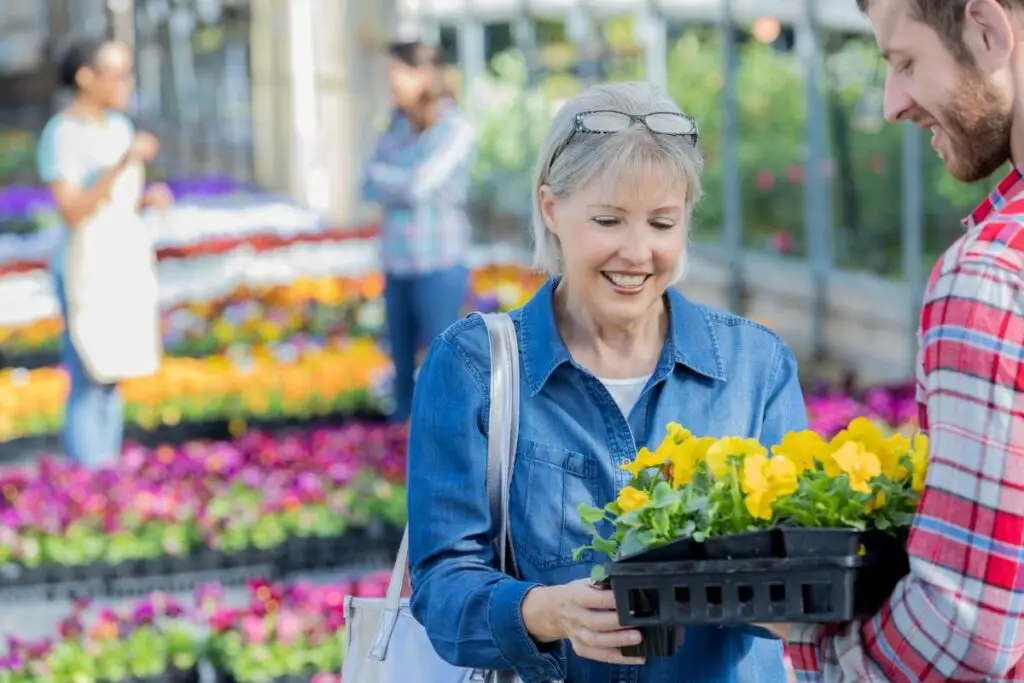
Are pansies high maintenance plants?
Pansies are popular cool-season flowers, they require minimum maintenance, and they are easy to grow plants. They need minimal deadheading to keep blooming throughout the spring. They need direct sunlight and moist soil for growth.
How long do potted pansies last?
Pansies are short-lived perennials. You can grow them as annuals or biennials. These are usually planted for one season. If you are planting them in the fall, then they will last up to eight months.
For instance, if you are planting pansies in September, it can last till April or May. But if you want to grow them as biennials or perennials, you should not plant them in containers.
Also read: What To Do With Pansies At End Of Season? (Pansies Life Cycle)
How can you make your pansies bloom more?
You can encourage the blooming of your pansies in many ways. You can use rich fertilizers to encourage the growth of their roots. Fertilizers rich in phosphorus like bone meal promote flowering. Deadheading and pruning also encourage flowering.
You must remove non-productive sections of pansies like some stems or foliage that deprive the prolifically blooming parts in pansies. Also, provide an adequate amount of sunlight and water.
Also read: How To Make Pansies Bloom More?
Are pansies poisonous to pets?
Pansies are edible flowers with a mild, fresh flavor or a more prominent wintergreen taste. They are non-toxic for humans. Pansies are not considered poisonous to pets, but it has some toxicity that is not very safe for pets.
Pets tend to like pansies because of their texture and taste. This potential toxicity in pets can happen because of improper use of plants or consuming pansies in high amounts.
Pets like dogs and cats can experience oral and skin irritation, vomiting, diarrhea, etc. The Saponins present in the pansies cause such problems to your pets.
But pansies are not harmful to all kinds of pets. Some, like rabbits, squirrels, or rats, love to eat pansies.
Also read: Are Pansies Poisonous To Pets? (Cats, Dogs, Rabbits & More)
Ref: The University of Arkansas, Britannica, Utah State University, Wikipedia, The University of Georgia, The Pennsylvania State University, The Royal Horticultural Society.
